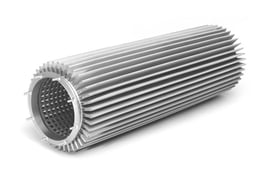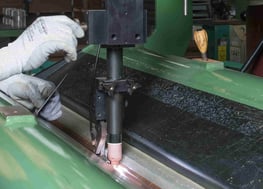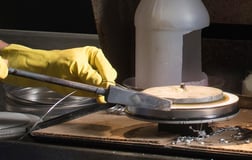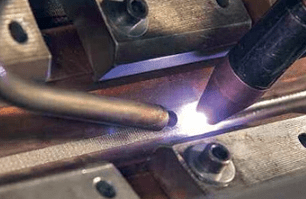4 Types of Welding Techniques Used on Woven Wire Mesh (Spot, TIG, Plasma, and Solder)
When it comes to fabricated wire mesh components, the list of possibilities is virtually endless. Whether you’re filtering out impurities from recycled plastic or using it as a sand control medium in a wellbore, woven wire mesh is one of the most versatile solutions out there.
That being said, the effectiveness of your wire mesh solution is often dependent on the type of welding technique used during its construction. So, what welding technique suits your particular needs most?
With over 150 years of woven wire mesh experience, W.S. Tyler is here to help you identify the welding techniques that will enable you to achieve results that you are proud of.
This article will provide insight into some of the most commonly used welding types, the advantages and disadvantages of each one, as well as the factors that determine pricing.
How Is Wire Mesh Welded?
There are four main welding techniques used to affix wire mesh: Spot/Resistance welding, Tungsten Inert Gas (TIG) welding, Plasma Welding, and Soldering. We will now dive into the pros and cons of each.
1. Spot/Resistance Welding?
Spot welding, also referred to as resistance welding, is the process in which an electrical current is used to generate heat and bond the desired material.
Most of the time, spot welding is used when a single layer of wire mesh needs to be joined to itself. This type of welding can be seen in our sock screen gaskets, which are spot welded at the overlapping seam in order to retain its cylinder-like profile.
Spot welding is also used to loosely bond multiple layers of mesh. In other words, the mesh layers are stuck together without having the complete bond that other welding techniques would create.
A good example of multiple mesh layers being spot welded together can be seen in our extruder screens.
When Should I Spot Weld?
Spot welding is possibly the quickest of all the welding techniques. This can be crucial whenever there is a spike in demand for a specific product or your process relies on a quick turnaround.
As it also stands as the least harsh technique, spot welding is an ideal solution if you are working with delicate mesh specifications.
That being said, there is still some risk of damage associated with spot welding.
As stated above, this method employs an electrical current to heat the material and create the bond. If the voltage is too high for the material being bonded, you may burn through the material rather than bond it together.
If you’re going to use this method, it is vital that your staff is well-trained on what voltage to use for the material being worked with. Failure to properly train your staff may result in wasted material and time.
In addition, the bond that spot welding creates does not look the best. If aesthetics are a concern, you may want to look into how you can apply one of the other welding options to the material you are working with.
2. Tungsten Inert Gas (TIG) Welding
TIG is the welding technique that uses a tungsten electrode to bond components to each other.
In order to TIG weld wire mesh, you need to use a thicker wire diameter. If you use it on thinner, more delicate material, such as single layers of mesh, you run the risk of ruining it.
So, for example, when forming our POROSTAR® wire cloth, TIG welding is used to bond the multilayer sheet of sintered mesh to the end pieces of the filter.

When Should I TIG Weld?
TIG welding creates a complete seal between what is being welded. It is especially good for applications in which the final product cannot leak under any circumstances, such as a filtration part.
While the performance is the most valuable aspect of any wire mesh component, TIG welded material can become fairly expensive. This is because looks also matter in a lot of applications, and TIG welding provides the best-looking seam.
Having said that, the downside of TIG welding is that it’s both expensive and slow. In other words, if you are looking for a quick turnaround on products or to cut the expenses of your operation, TIG welding may not be a good fit for you.
3. Plasma Welding
Plasma welding is similar to TIG welding. It involves using the plasma arc found in a Tungsten electrode to bond thick material together.
Unlike TIG welding, however, plasma welding can be carried out in an automated process, reducing the chances of user error. It is generally used when working with long, cylindrical components, such as our premium sand control screens.
When Should I Plasma Weld?
Again, plasma welding is identical to TIG welding. It creates the same permanent bond needed to minimize holes, leaks, or faults.

It also creates a smooth, good-looking seam that customers often find desirable.
The major drawback of plasma welding is that it is only beneficial when used in applications where an automated system is bonding long, cylindrical materials.
To that end, the software used during the automation process can sometimes be difficult to understand and use. This means there is an increased risk of the operator inputting the wrong parameters, which could result in an ineffective bond.
4. Soldering
Soldering is a little different than most welding techniques. Typically, when you weld two pieces of material together, you are bonding the separated pieces, creating one unified piece.

Soldering, on the other hand, is the process in which a low-melting alloy is used as an agent to bond material.
When Should I Solder?
Soldering works great in situations when materials cannot overlap at the seam. If there is a fine joint between what's being bonded or the material itself is delicate, soldering is also a great solution.
Now, it should be noted that soldering takes time. It is not ideal for industries where time is money.
Soldering also requires specific fixtures to be done properly. If you are working on a custom solution that you rarely encounter, soldering may not be the most practical solution.
How Does Welding Affect the Cost of a Wire Mesh Component?
To determine how much a particular wire mesh component will cost, you must first look at the material being worked with, as this will dictate what welding method is used.
Single layers projects require a less robust joining process, such as spot welding, and are generally inexpensive.
Projects that are more critical and require expensive material, such as POROSTAR, to undergo a high-quality, labor-intensive joining process tend to be on the pricey side. These are jobs where TIG and plasma welding excel.
Lastly, when a project requires delicate material to be bonded with no signs of overlap, this requires a fair amount of attention to detail. The only way to effectively achieve this type of bond is with soldering.
While not as expensive as TIG or plasma welding, the labor associated with soldering places it in the middle of the road when talking pricing.
Perfect Your Wire Mesh Components With the Right Heat-Treatment Process
In order for wire mesh components to produce the desired result, you must implement a welding technique that will provide the durability and cost-effectiveness your particular operation calls for.
Spot welding is the process in which an electrical current is used to heat the material and create a bond. It is the perfect solution for those looking for the quickest possible welding solution.
TIG welding is a welding technique that employs a tungsten electrode to bond thick pieces of material together. If you are looking for a quality weld that looks great, TIG welding may be right for you.
Plasma welding involves isolating the plasma arc from a tungsten electrode to bond thick material together. While it resembles TIG welding, it is typically only used when working with long, cylindrical material.
Lastly, soldering uses a low-melting alloy to bond the ends of delicate material. It is the ideal solution when the seams of the material being worked with cannot overlap.
Now, while welding is critical to bonding wire mesh components, the wire mesh itself must be formed before its welded. As it is critical to the efficiency and effectiveness of the forming process, you must take the time to understand the benefits of the various heat treatment processes available.
W.S. Tyler has been in the wire mesh business for over 150 years, helping customers in countless industries weave optimal results into reality. We strive to share the experiences we've had over the years to help you develop a solution tailored to your specific needs.
To learn more about how woven wire mesh is heat treated, refer to the following article:
About Ronnie Brown
Ronnie is the Content Writer for W.S. Tyler and has four years of experience as a professional writer. He strives to expand his knowledge on all things particle analysis and woven wire mesh to leverage his exceptional writing and graphic design skills, creating a one-of-a-kind experience for customers.




